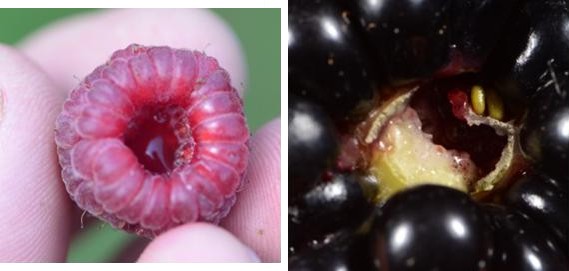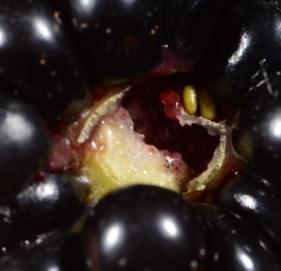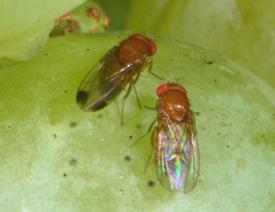Spotted Wing Drosophila And Backyard Small Fruit Production
ENTFACT-231: Spotted Wing Drosophila & Backyard Small Fruit Production | Download PDF
Jessica Bessin, Patty Lucas, and Ric Bessin
University of Kentucky College of Agriculture
Spotted wing Drosophila (SWD), Drosophila suzuki, is a serious invasive pest of soft-skinned fruits. SWD was first detected in Kentucky in 2012, by midsummer of 2013 SWD could be found throughout Kentucky at high levels. This fruit fly lays its eggs in soft-skinned fruits as they soften before harvest; this new pest not only causes issues for the commercial grower but the home gardener as well. SWD attacks many different soft-skin fruiting crops, but the most serious damage in 2013 was to raspberries, blackberries, blueberries, and grapes. It also breeds in fruit of native wild plants like pokeweed, mulberries, wild blackberries, and nightshade. The female SWD uses her serrated egg layer (ovipositor) to cut into the skin of otherwise intact soft-skinned fruits to deposit her eggs. Each female deposits 7 to 16 eggs a day and up to 300 eggs during its lifetime. Eggs hatch in 2 to 72 hours, resulting in small larvae in harvested fruit. SWD will overwinter in Kentucky as it survives in states to our north and parts of Canada.

Figure 1. A male (left) and female SWD.
Identification
Adult SWD have an amber body color, red eyes, dark banding on their abdomen, and clear wings. The male SWD, easier to identify than the female, has a black spot on each wing and has two small dark bands on its front legs. Female SWD, lack the spots on their wings and banding on the legs, have to be identified by looking at their serrated ovipositor and wing-vein characters. Many gardeners find larvae in the fruit before noticing the fruit flies around the plants themselves. The larvae are white and may reach ¼ inch in length.
Checking Fruit
When harvesting take the time to thoroughly look over each berry. Externally berries may look unifested but larvae may still be inside. If a berry is very soft, collapsing on itself, or is watery near the cap of the fruit, SWD larvae are most likely present. These berries should be discarded away from the field, and preferably bagged for disposal. We are not aware of any known risk to human health by ingesting SWD eggs and larvae.

Figure 2. A blackberry and raspberry showing a watery attachment as a result of SWD damage.
Management
Refrigeration: Berries that have no visible damaged should be placed directly in the refrigerator. Placing the berries in the refrigerator will stop the development of the SWD if they are present, both hatched and unhatched. Freezing berries will kill SWD and holding berries at 34F for 72 hrs will kill most of the eggs and larger larvae.
Netting: Mechanical control maybe an option for homeowners, as with many of the small fruit crops we often use netting to keep the birds from eating the berries. For the SWD the same concept applies except the netting must be a fine mesh, with opening of less than 1 mm. ProTekNet is a brand of netting that provides netting small enough (less than a 1mm square opening) that can exclude SWD, but spun bond row covers should work as well. Netting should be placed over the planting when the earliest berries begin to turn color prior to harvest. Netting may interfere with pollination of later raspberry flowers, but this maybe a sacrifice to save the rest of the crop. The netting must be secured along the ground to prevent any openings for SWD to enter. On larger plantings a structure might be installed to help support the netting and allow a person to pick underneath the netting. The netting will have to remain over the crop until harvest is finished.
Sanitation: It is also important to remove any damaged fruit from the field, as these fruits may contain SWD eggs and larvae. Overripe, damaged, or rotting fruit should be collected, placed in clear bags, and left in the sun. Burial of infested fruit is ineffective as the larvae can emerge from depths of one foot or more.
Trapping: Trapping can be used to monitor SWD and possibly reduce their numbers. Traps are used to detect SWD presence and are being evaluated in the NE US for home garden situations to be used as a method of control when placed no more than 30 feet apart. SWD is attracted to several kinds of traps using apple cider vinegar or yeast baits. These traps are simple to make at home. For information on recommended baits and trap designs see http://www.fruit.cornell.edu/spottedwing/pdfs/SWDTraps_CornellFruit.pdf. For large commercial plantings, traps have not been able to reliably predict SWD presence prior to their detection in fruit.
Floatation Method: Small fruit growers can use the fruit floatation method to sample small fruit periodically for SWD. Only samples of fruit that appear undamaged should be tested for SWD. To sample fruit for SWD larvae a simple floatation method can be used. Place about a dozen ripe, apparently undamaged fruit into a gallon bag. Add a cup of sugar syrup (mixture of ½ cup sugar mixed into 1 quart of water) to the bag and seal the bag. Thoroughly mash the berries, then let the berries settle to the bottom of the bag, any small, white larvae present should float to the top.

Figure 3. An apple cider vinegar baited SWD trap.
Chemical Control: Insecticides can also be used as management for SWD. Using insecticides is costly for the homeowner with the need for spraying equipment, cost of insecticides, and the amount of time needed to spray each week. If a homeowner decides to spray applications will need to start when fruit begins to turn color and soften. Good spray coverage is essential, especially the leaf undersides and the denser parts of the plant canopy where the SWD can be found throughout most of the day. Insecticides must be applied weekly as the crop starts to ripen and through harvest. Persons using insecticides to control SWD need to be familiar with and follow Pre Harvest Intervals (PHIs) for each specific insecticide spray. A PHI is the minimum amount of time between the insecticide application and when it is safe to harvest. This is the period of time needed for the residues to breakdown to acceptable levels. The type of insecticides being used must be rotated weekly to prevent the SWD from becoming resistant. If the decision is made to spray an insecticide, make sure to follow the instructions carefully. Some spray materials may not provide a week of control.
Managing SWD takes a lot of work but it is doable. Important points for SWD management are: recognizing the pest, trapping/monitoring, removing wild host plants, using netting prior to the berries ripening, placing picked berries directly in the refrigerator and cleaning up after harvest to help reduce the numbers of SWD.
Acknowledgement
The authors thank John Strang for his review of this factsheet and his helpful comments.
Revised 11/19
CAUTION! Pesticide recommendations in this publication are registered for use in Kentucky, USA ONLY! The use of some products may not be legal in your state or country. Please check with your local county agent or regulatory official before using any pesticide mentioned in this publication.
Of course, ALWAYS READ AND FOLLOW LABEL DIRECTIONS FOR SAFE USE OF ANY PESTICIDE!
Images: University of Kentucky College of Agriculture
